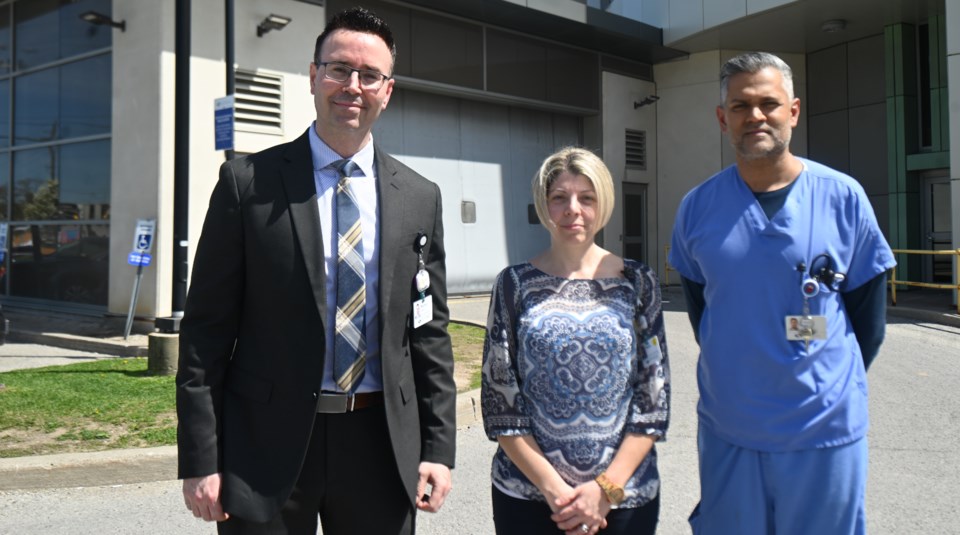Southlake Regional Health Centre chief of emergency medicine Dr. Gaurav Puri can recall a time when the halls of the emergency department weren't always crammed with stretchers and lined with people awaiting care.
When he first joined the hospital in 2011, he said it was not common to see so many stretchers in the hallways of the Newmarket hospital.
Now, the unit's halls daily fill with people waiting, on chairs or standing, or on stretchers until they can be admitted to a bed in the overcapacity hospital — too many patients for too small a space.
“We are getting more people who require acute care spaces, and because our infrastructure hasn’t necessarily changed, we have to make do by holding people in hallway stretchers,” the emergency chief said. “They’re only here because the hospital is filled with patients just like this.”
With no new hospital building on the horizon, the Newmarket hospital is taking a new route. It plans to convert an ambulatory garage into additional emergency department space and has released a call for tenders this week to make that happen, NewmarketToday has learned.
The expansion will help the emergency team better care for patients requiring short-term treatment, according to Southlake's director of emergency and mental health, Stella Johnson. The expanded area will have capacity for about 50 people, those who don't need a bed, and will offer more space for patients waiting for care.
“(It's about) keeping patients who are able to sit in chairs with their family members and providing a work environment for staff and providers that is significantly better than the work environments that they’re provided today,” she said.
That environment today is a challenging one. While Southlake remains tops in the province for the time in which patients are first assessed in an emergency due to its unique triage process, it has struggled with how long patients wait to be admitted from the emergency department.
Due to capacity problems, those waiting for hospital stays can be stuck in the emergency department for an average of 18 hours or more.
That has led to some horror stories from residents sometimes left stuck waiting for hours in potentially uncomfortable positions.
It is an issue Southlake acknowledges and it is part of the drive to build a new hospital to meet the demands of the growing population.
“Patients waiting in hallways, elderly people with bright lights shining on them,” Puri said. “Not ideal from a space perspective (and) patient experience perspective.”
The situation is difficult and stressful for hospital staff, as well, Puri added, having to navigate through crowded, noisy hallways.
“Everyone’s working really hard. There’s always movement,” Puri said. “It’s not pleasant for patients, of course, but for everyone working here, the extra volume of people who are here physically, and then the sound, it just adds to their work experiences.”
To help address the challenges, the hospital intends to fully convert the neighbouring ambulance garage to additional emergency department space. The construction process is expected to be 12 to 16 months, with a second phase improving the entrance to the emergency department where patients are first assessed.
Johnson said Southlake will transform the garage area to look and feel like a natural extension of the emergency department. She noted the area had alternative uses before it was a COVID-19 drive-thru assessment area.
“COVID demonstrated the utility of different spaces and our ability to be nimble and creative,” she said. “For us, there was no other option, and we need to act now … Patients are showing up every single day, almost 400 of them. They are individuals in this community, and we can do better.”
She further said that they have kept in contact with their ambulance partners throughout the planning and the ambulance services should still be able to get proper access to the emergency department with the change.
However, the change will not reduce the need for a new hospital, officials emphasized. Southlake has been planning to build a second hospital campus, but has struggled to find nearby land. And a new hospital would be many years from opening.
“The new space addresses one big issue and that’s the risks of overcrowding. The risk to exposure to patients and the risks to staff around what their environment is that they’re working in for 12 hours per day,” Johnson said. “What the expanded space does not address, that is top of mind, are wait times. So there are no additional places for a patient who is admitted (into hospital) to go in this new space.”
“The work that this team is doing is trying to maximize those resources that are within our disposal,” director of communications and government relations Derek Rowland said. “To address the immediate need while the conversations with the government for a new hospital are still ongoing.”
Officials said there is excitement among staff about the renovation and the improvements it could bring.
“Almost every patient in this community knows someone who’s worked in our emergency department or has used our emergency department. And this renovation is really the way that we can keep retaining our staff, attracting new staff, and ensuring that our patients get the best care that’s possible in this physical location,” Johnson said.



